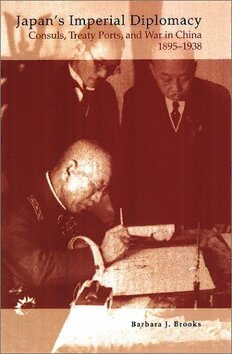
Japan's Imperial Diplomacy: Consuls, Treaty Ports, and War in China, 1895-1938 PDF
Preview Japan's Imperial Diplomacy: Consuls, Treaty Ports, and War in China, 1895-1938
Japan’s Imperial Diplomacy Consuls, Treaty Ports, and War in China 1895–1938 Barbara J. Brooks Japan’s Imperial Diplomacy A Study of the East Asian Institute Columbia University Japan’s Imperial Diplomacy Consuls, Treaty Ports, and War in China 1895–1938 Barbara J. Brooks University of Hawai‘i Press Honolulu © 2000 University of Hawai‘i Press All rights reserved Printed in the United States of America 05 04 03 02 01 00 5 4 3 2 1 Library of Congress Cataloging-in-Publication Data Brooks, Barbara J., 1953– Japan’s imperial diplomacy : consuls, treaty ports, and war in China, 1895–1938 / Barbara J. Brooks. p. cm. Includes bibliographical references and index. ISBN 0–8248–2062–2 (alk. paper)—ISBN 0–8248–2325–7 (pbk. : alk. paper) 1. Japan—Foreign relations—China. 2. China— Foreign relations—Japan. 3. Japan—Foreign relations— 1868– 4. China—Foreign relations—1644–1912. 5. China—Foreign relations—1912—1949. I. Title. DS849.C6 B67 2000 327.52051—dc21 00–021819 Studies of the East Asian Institute, Columbia University The East Asian Institute is Columbia University’s center for research, publication, and teaching on modern East Asia. The Studies of the East Asian Institute were inau- gurated in 1962 to bring to a wider public the results of significant new research on modern and contemporary East Asia. University of Hawai‘i Press books are printed on acid-free paper and meet the guidelines for permanence and dura- bility of the Council on Library Resources. Designed by Ayda Utku/Text Noumena Printed by The Maple-Vail Manufacturing Group To my parents Contents Acknowledgments/ix Introduction/1 1 The Rise of Kasumigaseki Diplomacy/15 The Struggle for Autonomy 2 The Development of the Career Diplomat/45 Nurturing China Expertise 3 The Japanese Consul in China/79 4 TheGaimushò’s Loss in the Manchurian Incident/117 5 The Path to War/160 TheGaimushò’s Continuing Loss of Control in China Affairs Conclusion/208 Notes/215 Bibliography/263 Index/281 Acknowledgments I am indebted to a senior generation of scholars for the initial concept and guidance for this book. Marius Jansen has been a patient and attentive supporter from start to finish; I consider it one of my greatest fortunes to have been among his students. Although the project began at his suggestion, a few years later, Kurihara Ken, the senior scholar of the Japanese Foreign Ministry, shared his vision of the project with me in a conversation at the archives. In the years since then, I have come to much greater appreciation of his words, although I alone am responsible for the resulting book in the form it has taken. Along the way, I received support and advice from so many friends and fellow researchers in Princeton, New York, Montreal, and Tokyo. Many thanks to Furuta Kazuko, Kojò Yoshiko, Endò Yasuo, Notòji Masako, Matsui Midori, Umemoto Tetsuzò, Michael Birt, Bob Wakabayashi, Stephen Roddy, Martin Heijdra, Michael Tsin, Tak Matsusaka, David Howell, Mark Seralnick, Sylvano Mahiwo, Nishizawa Haruhiko, Adam Kabat, Greg Pflugfelder, Alice Conklin, Faye Kleeman, Mary Brinton, Barbara Hamill Satò, and Linda Penkower. In Tokyo, Hirano Kenichirò deserves the greatest acknowledgment for his kind and patient mentorship dur- ing more than one sojourn in Japan. He is among the warmest of Japanese hosts to myself and my family in recent years. Other scholars who have lent me time, guidance, and encouragement in- clude Baba Akira, Etò Shinkichi, Hata Ikuhiko, Kitaoka Shin’ichi, Iino Masako, Enatsu Yoshiki, Mark Peattie, Sheldon Garon, Peter Duus, Hamashita Takeshi, Ikei Masaru, Sally Hastings, Richard Smethurst, Sharon Minichiello, Kent Calder, and Arthur Waldron. Josh Fogel deserves special thanks for his encouragement, good humor, curiosity, and help through the years. Many institutions have given me support for my research and writing. Princeton University offered me vital graduate support. I benefited immensely as a researcher affiliated with Tokyo Univer-
